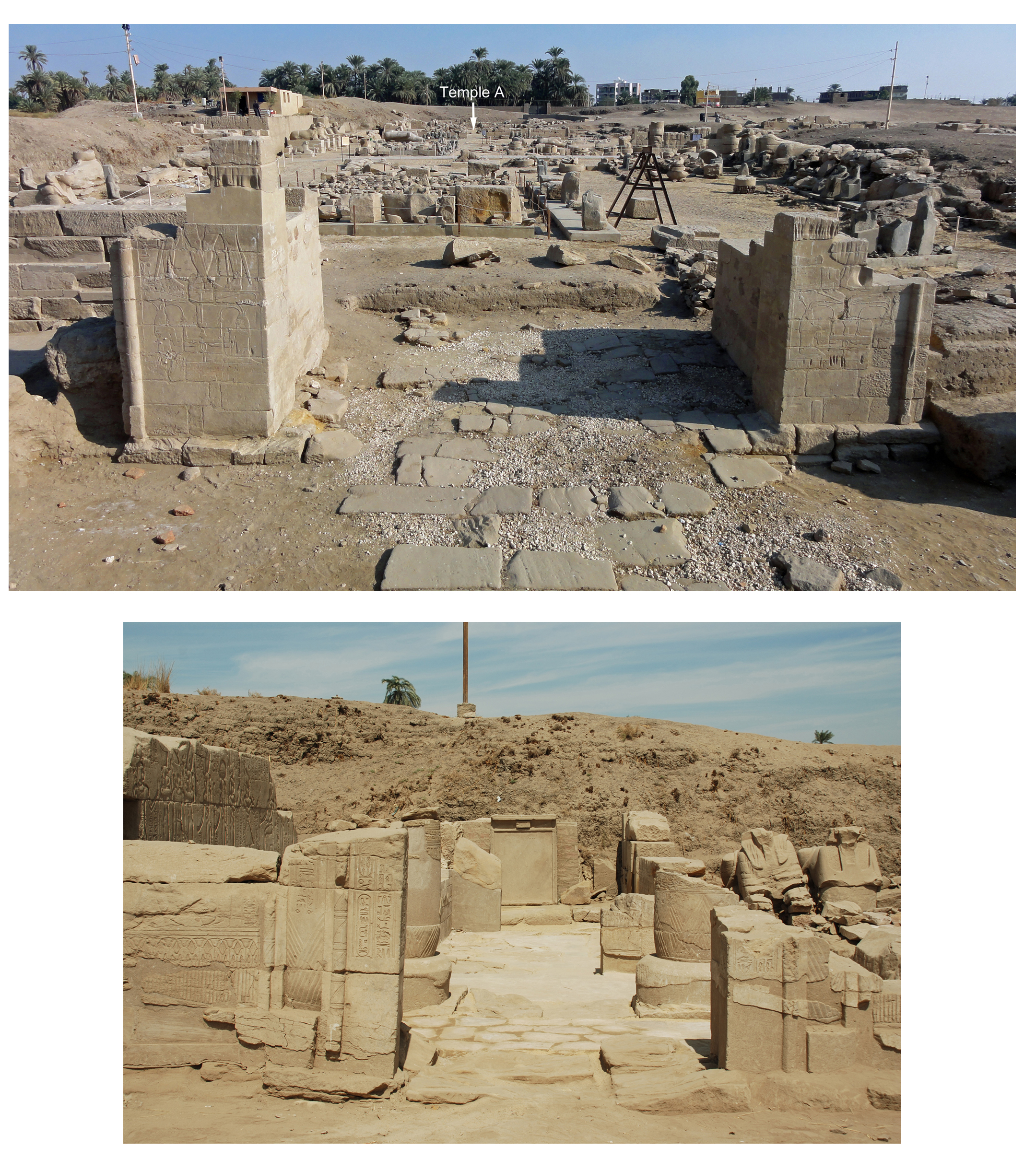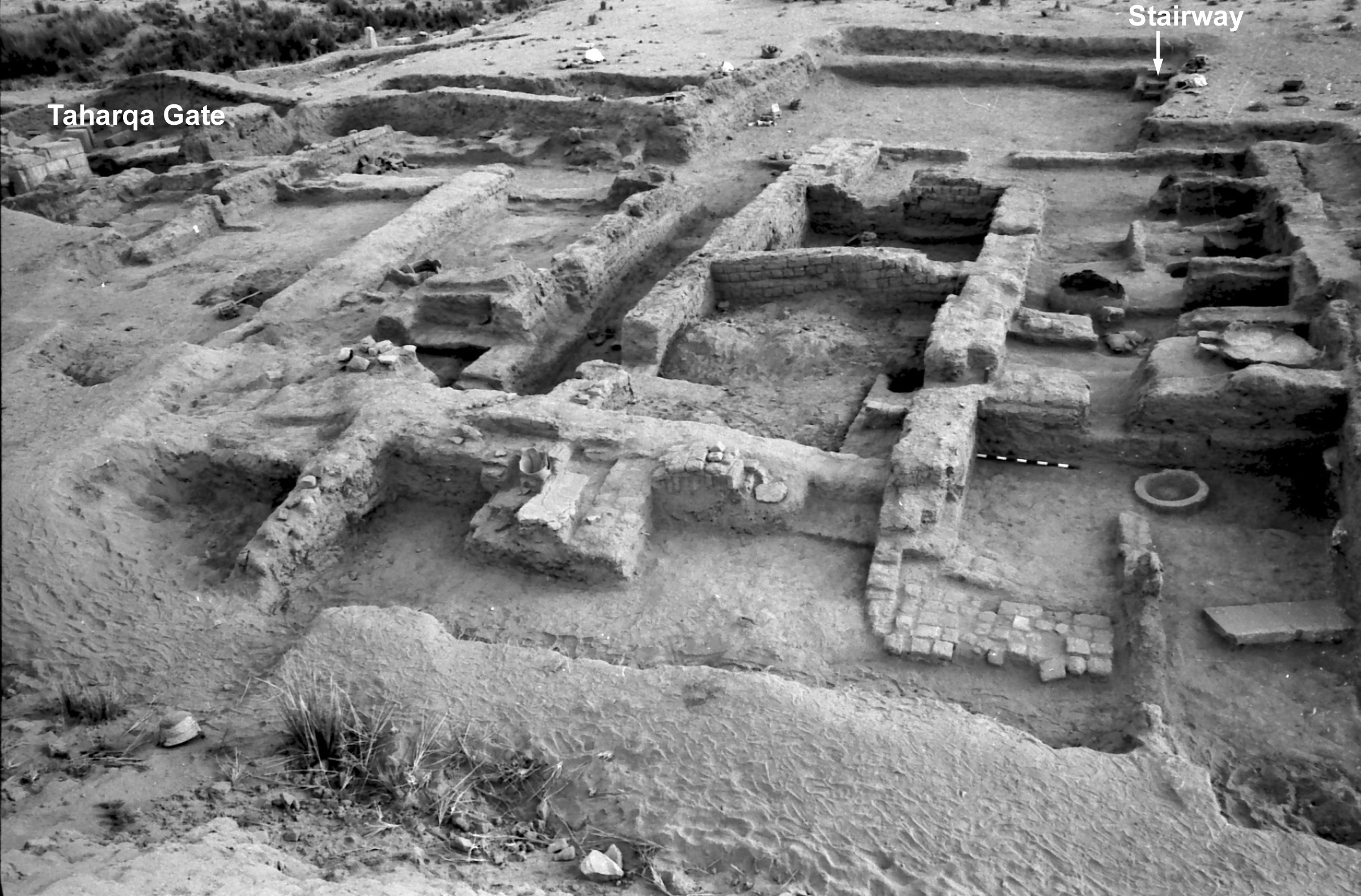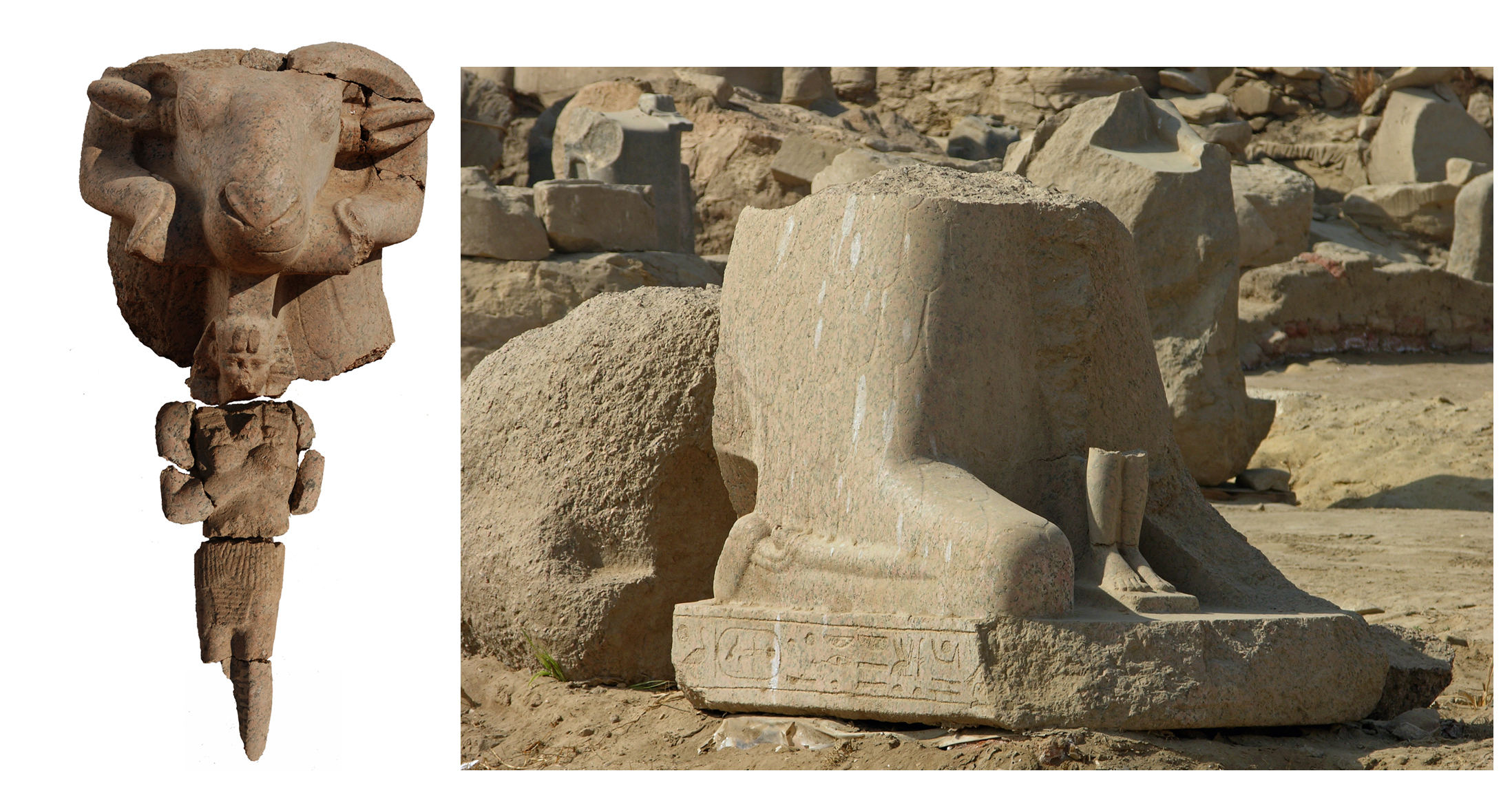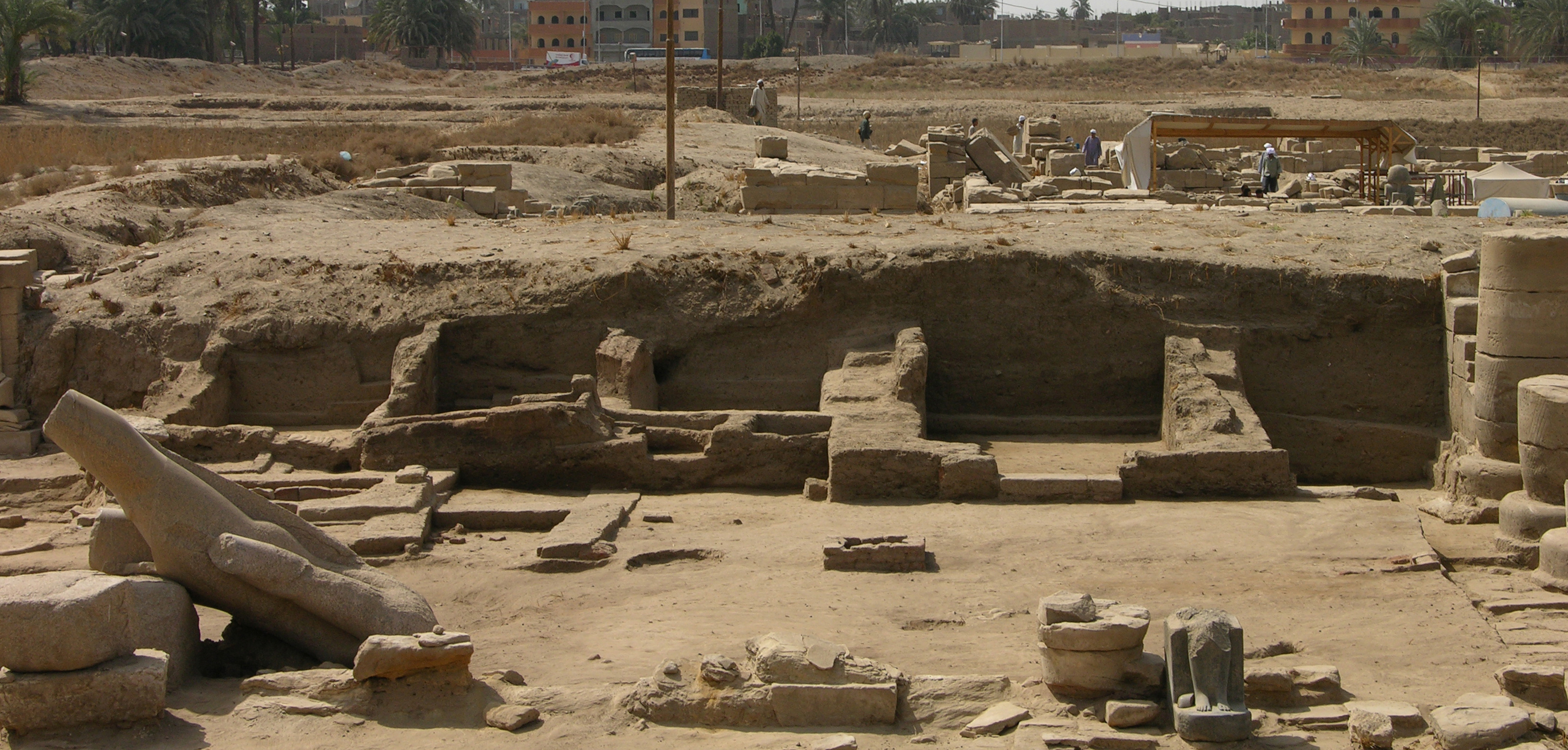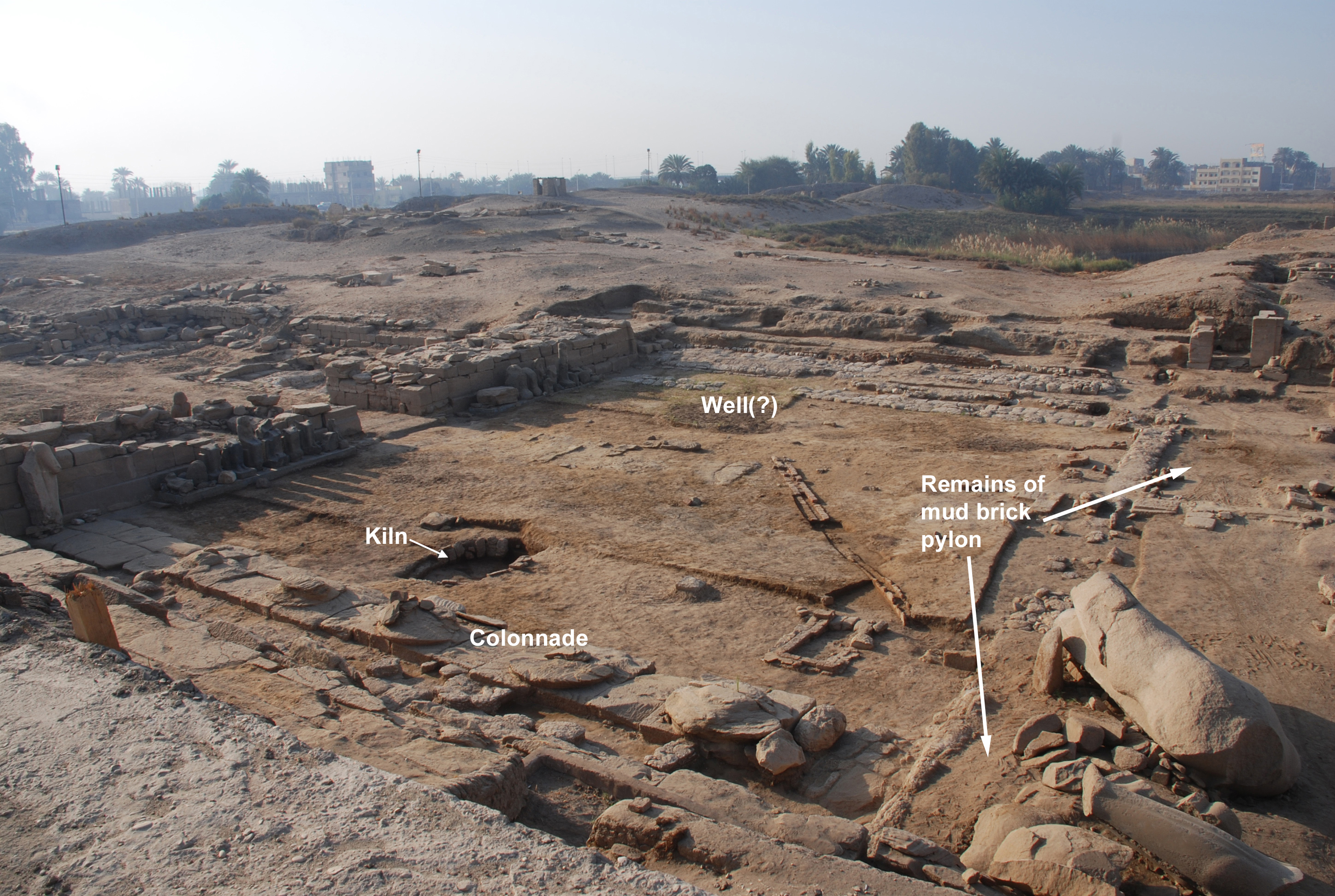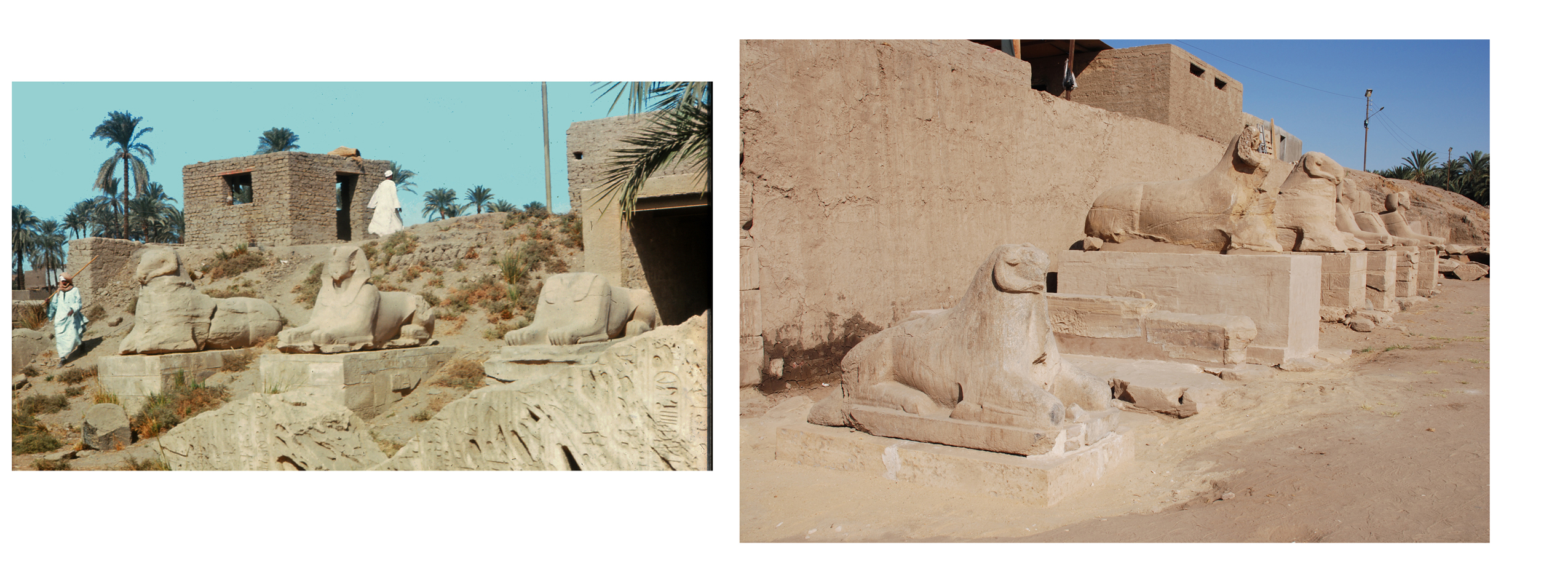- EraPharaonic
- Project DirectorRichard A. Fazzini
- LocationLuxor
- AffiliationBrooklyn Museum
- Project SponsorBrooklyn Museum
- Project Dates1976-Present
Mut was a daughter of the sun god like Sekhmet, Hathor, Bastet, Nekhbet and others — goddesses known as the “Eye of Re.” They were both benign and dangerous and could appear as gentle cats or fierce lionesses. Because they influenced the Nile floods and could both cause and cure disease, their cults were vital to Egypt.
Mut’s other role, which assumed greater importance from the reign of Amunhotep III on, was as consort of Amun and mother of Khonsu. She is usually portrayed as a woman wearing the Double Crown, signifying her task of protecting the office of kingship and the king himself. Mut’s primary cult center was at South Karnak, linked to the Amun Precinct by an avenue of rams. Covering over 20 acres, it contains three major temples. The Mut Temple itself is girdled by a horseshoe-shaped sacred lake (the Isheru), a type specific to Eye of Re goddesses. The earliest preserved structures date to Hatshepsut and Thutmosis III, but the Johns Hopkins University Mut Expedition discovered evidence of a Middle Kingdom temple under the later construction. Until Dynasty 25, the Mut Precinct consisted only of the Mut Temple and the sacred lake.
Aerial view of the Mut Precinct showing the major features. Photo: J. van Rensselaer IV for the Johns Hopkins University Mut Expedition
Temple A, to the northeast, lay outside the precinct until Dynasty 25. It is so called because its ancient name is mostly unknown, but by the reign of Ramesses II it was a “Temple of Millions of Years”. Ramesses II added a forecourt and pylon fronted by two colossal alabaster stelae and two colossal statues, both usurped from Amunhotep III. The stelae, created from blocks of a chapel of Amunhotep II, record Ramesses’s marriage to a Hittite princess and his refurbishing of a temple. By the Third Intermediate Period the temple was a mammisi, which it remained for the rest of the site’s history.
To the southwest of the sacred lake lies a temple of Ramesses III, also originally outside the Mut Precinct. In Dynasty 25, Taharqa brought Temple A and the area north of the Mut Temple into the precinct. The gate he built in the new west enclosure wall opened a processional way to Temple A, now bearing scenes of Taharqa’s divine birth and acceptance by the gods.The precinct achieved its final size in the 4th century BC when either Nectanebo II or an early Ptolemy added the propylon and built massive enclosure walls that encompassed Temple A, the Ramesses III temple and the area south of the Isheru.
Exploration:
The Napoleonic expedition was the first to map the site, and a few other 19th century explorers recorded visits. Auguste Mariette excavated the Mut Temple in the 1850s and 1860s, discovering a small chamber in the second court’s east wall decorated with a relief of Taharqa, Montuemhat (Fourth Prophet of Amun, Mayor of Thebes and Governor of Upper Egypt) and family offering to Mut. Inscriptions on other two walls describe Montuemhat’s works in the Mut Temple and southern Egypt.
The first official excavations took place in 1895-97, led by Margaret Benson and Janet Gourlay, the first women to direct an expedition in Egypt. In the 1920s, Maurice Pillet, Director of the Egyptian Antiquities Organization, cleared Temple A and the Ramesses III temple, and further sporadic excavations took place in the 1950s.
The Brooklyn Museum Expedition:
In 1976, the Brooklyn Museum began the first systematic exploration of the site as whole, to determine how the precinct developed and how the monuments relate to one another. The Detroit Institute of Arts participated from 1978 to 2010. In 2001 Brooklyn and an expedition from Johns Hopkins University, led by Dr. Betsy Bryan, agreed to share the site, with Brooklyn working from the Mut Temple’s first court to the Propylon and from Temple A to the northwest quadrant of the site and Hopkins taking over the rest, including the Ramesses III Temple and the area south of the Isheru. The expeditions operate independently but cooperate on conservation and preservation projects. A summary of Brooklyn’s major discoveries and achievements follows.
The east face of the Thutmoside gateway . Photo: M. McKercher.
Thutmoside gateway: The small gate west of the Isheru on 19th century maps had disappeared by 1976. Rediscovered by the Brooklyn expedition, it was inscribed for Thutmosis III and Thutmosis II (perhaps replacing Hatshepsut’s name). The gate and associated walls formed the western and northern limits of the precinct until Dynasty 25.
The Taharqa Gate and Ptolemaic Chapel: The walls of a small structure west of the Propylon were noted by Charles Edwin Wilbour in the 1880s. Brooklyn’s excavations revealed a Ptolemaic chapel abutting a massive gateway inscribed for Taharqa. The Taharqa Gate (not recorded on earlier maps) and its walls brought Temple A and the area north of the Mut Temple into the precinct and formed the site’s western limit until the 4th century BC.
The Taharqa Gate and the Ptolemaic chapel after restoration. Photo:M. McKercher.
Houses west of the Taharqa Gate, built after the gate was blocked. Photo: D. Loggie for the Brooklyn Museum Mut Expedition.
With the construction of the final enclosure walls, the Taharqa gate was no longer needed and was blocked up. The area to its west was leveled and a village grew up between the gate and new enclosure walls; it was occupied from the late 3rd-2nd centuries BC to the 2nd century AD. The Taharqa gate and walls, however, remained the western limit of the precinct’s sacred area.
Mut Temple Porches: Only the southernmost columns of the porches flanking the first pylon were visible in 1976, but in the “Montuemhat Crypt” Montuemhat records building a 24-column colonnade for the Mut Temple. Excavations revealed this colonnade: two porches of 12 columns each. The Ptolemies rebuilt the south end of each porch, adding two large reliefs of Bes on each side, but seem merely to have repaired the rest of the columns. At the south end of the west porch, a small chapel was built into the pylon. A hut-ka (“soul house”) for Montuemhat’s son, Nesptah, it is one of a number of small chapels that proliferated at the site in Dynasties 25-26.
The porches of the Mut Temple. Photo: M. McKercher.
Hut-ka chapel of Nesptah built into the pylon at the south end of the west porch. Photo: M. McKercher.
Ram’s head with king below his chin from the East Porch; forequarters of the ram with Taharqa’s cartouches from the West Porch. Photo: M. McKercher.
At the north end of the east porch the expedition uncovered the uninscribed head of a large pink granite ram with the figure of a king below its chin, clearly Kushite in style. Several years later, the companion ram was found north of the west porch, its head missing, but its base preserving Taharqa’s cartouches. It appears that the Ptolemies left both rams in place when they renovated the porches.
North of the Mut Temple’s First Pylon: A row of seven rams lines the west wing of the pylon, possibly placed there by Pinedjem and Henuttawy. There is no trace of such sculptures in front of the east wing. Instead, from the Ptolemaic period through the mid-2nd century AD this area was occupied by a row of vaulted rooms, ovens and a possible kiln.
Remains of vaulted rooms built against the east wing of the Mut Temple’s first pylon. Photo:M. McKercher.
Temple A: In clearing the forecourt of this temple, the expedition uncovered the foundations of the mudbrick pylon in front of which stood the two colossal statues and the Hittite Marriage Stela found by Pillet. To the south we found the companion stela describing building a temple, probably Temple A, located in Ipet. Both stelae were removed to Karnak’s Open Air Museum where the Amunhotep II chapel from which they came was rebuilt.
The forecourt of Temple A. Photo: M. McKercher.
Horwedja “magic healing chapel” rebuilt north of the Mut Temple’s first pylon Photo: M. McKercher.
The forecourt eventually became an industrial area, with the remains of a kiln in the north half and a well fed by ceramic pipes in the south. Mud brick structures built on the south side of the court in the late Ptolemaic or early Roman period incorporated a group of blocks from a “magical healing chapel” whose lintel had been re-used in the base a sphinx east of the Propylon. The lintel names Horwedja, Great Seer of Heliopolis, an important Dynasty 26 official little attested in Upper Egypt. In 2010 the expedition rebuilt the chapel north of the Mut Temple’s first pylon.
In the southeast corner of Temple A’s first court, Brooklyn found the limestone foundations of a small chapel, its sandstone lintel lying nearby. The chapel was dedicated to the God’s Wife of Amun, Nitocris I, and is a very rare example of a chapel to a private person built within a temple rather than within the confines of a temple precinct.
The chapel of Nitocris in Temple A’s first court (top) and its lintel (bottom).Photo: M. McKercher.
Preservation and Restoration:
Preservation has been a core task of the expedition. The first major project was clearing the rams and sphinxes east of the Propylon and rebuilding the enclosure wall behind them.
The sphinxes and rams east of the Propylon in 1976 and in 2008 Photo: R. Fazzini (left); M. McKercher (right)
The restored façade of the Contra Temple. Photo: M. McKercher.
In 1992, the small Contra-Temple behind the Mut Temple was restored , and in 2008-09 the expedition rebuilt the Taharqa Gate and Chapel D, both of which were unstable.
Rescuing the site’s Sekhmet statues, many half-buried, was perhaps the expedition’s most important project. Beginning in 1999 the expedition cleared and conserved all the statues in the Mut Temple’s first court, the area north of the temple, and in Temple A, placing them on new bases isolating them from ground water. Where necessary we rebuilt the mud brick walls behind the statues to protect them and to give visitors some idea of how the courts once looked. The Hopkins expedition did the same with the statues in their part of the precinct. The introductory image of this article shows the restored Sekhmet statues in the Mut Temple’s first court.
Credits:
The core staff of the expedition are:
- Richard Fazzini, Director (1976-present)
- William H. Peck, Co-Field Director (1978-2010)
- Mary McKercher, Assistant Director and photographer (1979-present)
- Jacobus van Dijk, Epigrapher & registrar (1986-present)
- Elsie H. Peck, archaeologist, artist (1978-2010)
- W. Benson Harer, pottery (1982-2016)
- Herman te Velde†, consultant on ancient Egyptian religion (1980-2018)
- Julia Harvey van Dijk†, pottery specialist (2010-2018)
Various conservators, both American and Egyptian have participated over the years as well, and the work could not have been carried out without the cooperation of the Ministry of Tourism and Antiquities, the assistance of the officials and inspectors of the Luxor office of the Supreme Council of Antiquities, and the expertise of the Egyptian workmen, in particular the technicians from Quft.
Sponsors:
The work of the Brooklyn Museum’s archaeological expedition to the Precinct of Mut, South Karnak has been made possible by the generosity of a number of corporations, foundations and individuals. The 1976-1979 seasons were funded primarily by the Coca-Cola Company of Atlanta, Georgia. Institutional funding for subsequent seasons has been provided by the Brooklyn Museum’s Charles Edwin Wilbour Fund and the Egyptian Art Council; The Founders Society and the Antiquaries of the Detroit Institute of Arts, the Samuel H. Kress Foundation, and the Long Island Society of the Archaeological Institute of America. Additional corporate support has come from Conoco, Inc.; the Getty Oil Company; American Motors, Inc.; and the Cairo Sheraton Hotel, Towers and Casino. Major funding was also provided by the following individuals, listed in alphabetical order: Kitty Brush; Richard Fazzini and Mary McKercher; Marjorie Fisher; Louis D. Fontana; W. Benson Harer, Jr.; Jo Ann Harris; Jack Josephson and Magda Saleh; John Moran; William and Elsie Peck; Harold D. Winters; Beverly Zweiman. In addition, the following people have also contributed to the work over the years: Heide van Doren Betz, Adelaide De Menil, James L. Frey, Howard Gilman, Theodore Halkedis, Charles Herzer and Adrienne Rourke, Mr. and Mrs. Sydney Jacoff, Reuben and Norma Kershaw, Alan May, Mrs. Henry L. Moses, Kathy Putnam, Carl and Florence Selden, and Emma Swann Hall. We thank them all for their generosity.

